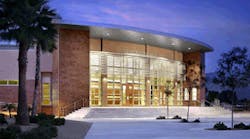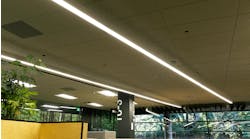Kids today use more technology than perhaps any generation before them — the Internet, computers, and sophisticated cell phones, to name just a few examples. So, it only makes sense that many of America's new high schools are incorporating high-tech systems into their designs, including VoIP telephone service, data networks, and broadband television as well as energy-saving features, such as daylight harvesting and occupancy sensors.
Shadow Hills High School represents one such high-tech educational facility. Designed by Ruhnau Ruhnau Clarke Architects, the $90-million public school, which is located in Indio, Calif., comprises 285,000 sq ft of classroom, faculty, and support spaces along with a pool complex, illuminated athletic fields, football stadium, performing arts theater, lecture hall, and a 3-court gymnasium.
“To meet Shadow Hills' power needs, we coordinated with the Imperial Irrigation District — the local serving utility — to provide two separate 4,000A services for the site, which are located on opposite sides of the campus for maximum efficiency,” states Alan Bravo, principal at Newport Beach, Calif.-headquartered FBA Engineering, the electrical engineering firm that designed the school's lighting, power, and low-voltage systems. “Because the project was located in an open rural area, special coordination was required to design major street improvements and underground infrastructure for utility services.”
To ensure the campus life safety systems remain powered during utility outages, FBA Engineering designed a 200kW diesel fuel engine generator to supply emergency power to the buildings and football stadium.
“Each building is equipped with its own power transfer switch, so that loss of power to any building will start the engine generator,” notes Bravo. “The main office has a remote annunciator panel for the emergency power system to indicate the status of power being provided to each building.”
In addition to the power distribution equipment, Shadow Hills contains a number of low-voltage systems, including VoIP telephone, data network, broadband television, public address and paging, master clock, intrusion detection, and IP-based closed-circuit surveillance camera systems. Furthermore, a fully automatic fire life safety system was provided per NFPA requirements.
“This includes smoke detectors, audible horns and visual strobe notification devices, and voice evacuation systems,” remarks Bravo. “Separate autonomous public address systems with components for the hearing impaired were supplied for the gymnasium, performing arts, and multi-purpose areas.”
To meet California Title 24 requirements and qualify as a California High Performance school, the campus includes a number of energy-saving and sustainable elements, such as occupancy sensors, photosensors, and high-efficiency lighting. According to Bravo, the school's lamps and ballasts are designed to work together as a system to achieve maximum efficiency. Lighting controls automatically turn off lights in unoccupied spaces, and lights in rooms with skylights or windows automatically dim in response to the amount of daylight entering the space. An energy management system turns off exterior lights during non-operating hours.
“Most interior spaces feature recessed low-glare fluorescent light fixtures,” he says. “Pendant-mounted fluorescent indirect light fixtures were used in the computer labs, and special theatrical lighting with dimming controls were provided for the performing arts building. The gymnasium utilizes pulse-start metal-halide lamps.”
Vandal-resistant compact fluorescents illuminate building exteriors, and metal-halide post-top lights illuminate the walkways. The parking lots are lit by high-pressure sodium lamps. To prevent light spillover onto surrounding properties, the stadium and athletic fields feature metal-halide sports floodlights with special cut-off shielding.
“These fixtures can be monitored and controlled remotely from the district office,” adds Bravo.
What made this project most unique for FBA Engineering, Bravo says, were the technology systems designed into the standard classrooms for student learning. These systems include overhead LCD projectors and A/V controls that allow television, Internet, document cameras, and other media material to be displayed.
“Furthermore, connectivity of data network systems was provided for teacher and student computer workstations and for wireless access equipment,” he notes.
Despite the enormity of the project, FBA Engineering's portion of the Shadow Hills High School project was completed on time as well as within budget. The school welcomed its first students in the fall of 2009.



